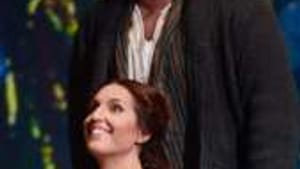Stay in the Loop
BSR publishes on a weekly schedule, with an email newsletter every Wednesday and Thursday morning. There’s no paywall, and subscribing is always free.
With a litle help from Van Gogh and Renoir
Opera Company's "La Bohème'

After 116 years of great popularity, you don't expect a director to unveil anything new and meaningful in Puccini's La Bohème.
After all, Bohème has been one of the world's most-performed operas since Arturo Toscanini conducted its premiere in 1896. The setting is specifically Paris in the era when tuberculosis was a deadly plague. And any director who tries to be too innovative will run afoul of Puccini's definite intentions.
The composer was theatrically precise, and his music reflects the story's smallest details: When a stove is lit, or a candle blows out or a cold wind blows, the orchestra illustrates the action.
So it was a pleasant surprise to behold the Opera Company of Philadelphia's new production. Director Davide Livermore kept the time and place where they should be, and he underlined this by using paintings from that period, using licensed digital images from the Art Museum, the Barnes Foundation and several other museums.
The production team animated these images in video-editing software and then created movies of the animated images that was rear-projected onto the sets and sometimes beamed onto Marcello's canvas.
Nighttime by Van Gogh
The Bohemian roommates of La Bohème include an artist, of course, so it's natural to see him painting and to see works by other artists that inspired him. The subjects of some of the paintings also have literary allusions that the poet Rodolfo would understand.
Thus Renoir's Woman Sewing appeared when Mimi described her job as a seamstress. Van Gogh's Sunflowers dominated the walls as her romance with Rodolfo bloomed, and Van Gogh's Starry Night was projected when evening came. When Rodolfo bought a bonnet for Mimi we saw Renoir's Girl With Pink Bonnet.
In Act IV, Jean Beraud's After the Misdeed showed a woman bent over, in a blue dress. Mimi arrived in that distressed posture, wearing a similar blue dress.
The painting Marcello was working on at the opening of Act III was Monet's Morning Haze, digitally enhanced to include branches that swayed back and forth. Through the windows of the Bohemians' apartment you saw Pissarro's cityscape, Morning Sunshine, but with clouds and chimney smoke that moved.
An intense Café Momus
The singers' actions were somewhat busy but true to the story line. The horseplay among the men seemed right for a bunch of young guys on the Left Bank. The Christmas Eve revelry at the Café Momus was intense but appropriate, with street hawkers, stilt walkers, a fire breather and the toy vendor Parpignol, while Musetta flirted with Marcello and her elderly date, Alcindoro, tried to satisfy her. To top it all off, a brass band marched across the stage.
I believe that Puccini would approve. No composer (save, perhaps, Meyerbeer) made such repeated use of theatrical spectacle. Witness Puccini's religious procession in Tosca, his horseback riding in Fanciulla del West and his Asian extravaganza in Turandot.
The singer-actors were ideally cast. Norah Ansellem was an uncommonly appealing Mimi. It would be good to have a Mimi whose voice embodied fragility, as Licia Albanese and Maria Callas did. But I know of no one of that type today, and Ansellem did a fine job of lightening her singing to indicate her character's accelerating weakness.
The warmth she radiated when she entered Rodolfo's cold apartment in the first act made it easy to see why he instantly fell for her— like "Some Enchanted Evening" before either Rodgers or Hammerstein were born.
Gay Bohemians, too
Bryan Hymel, a 2008 graduate of the Academy of Vocal Arts, was a stalwart Rodolfo, with singing that was ringing and sweet too. Troy Cook was the artist Marcello, with excellent voice and interacting nicely with the others. Leah Partridge was a Musetta who believably moved from superficiality to a loving caretaker for the dying Mimi.
Kevin Glavin excelled as Benoit the landlord in Act I and the bumbling Alcindoro in Act II. Jeremy Milner (another AVA graduate) was the deep-voiced Colline, and Craig Verm sang the baritone Schaunard.
Corrado Rovaris was the sensitive conductor. The orchestra rarely has sounded as good at an Opera Company production.
One unusual piece of business was subtle and intriguing. During the playful high jinks of the roommates, when Schaunard impersonated a dancing woman, Colline gave him a quick kiss on the lips. After Mimi died, those two men hugged each other in consolation. It is not out of the question that Bohemians in Paris in the 1890s might, just possibly, have been gay and accepted as such.
After all, Bohème has been one of the world's most-performed operas since Arturo Toscanini conducted its premiere in 1896. The setting is specifically Paris in the era when tuberculosis was a deadly plague. And any director who tries to be too innovative will run afoul of Puccini's definite intentions.
The composer was theatrically precise, and his music reflects the story's smallest details: When a stove is lit, or a candle blows out or a cold wind blows, the orchestra illustrates the action.
So it was a pleasant surprise to behold the Opera Company of Philadelphia's new production. Director Davide Livermore kept the time and place where they should be, and he underlined this by using paintings from that period, using licensed digital images from the Art Museum, the Barnes Foundation and several other museums.
The production team animated these images in video-editing software and then created movies of the animated images that was rear-projected onto the sets and sometimes beamed onto Marcello's canvas.
Nighttime by Van Gogh
The Bohemian roommates of La Bohème include an artist, of course, so it's natural to see him painting and to see works by other artists that inspired him. The subjects of some of the paintings also have literary allusions that the poet Rodolfo would understand.
Thus Renoir's Woman Sewing appeared when Mimi described her job as a seamstress. Van Gogh's Sunflowers dominated the walls as her romance with Rodolfo bloomed, and Van Gogh's Starry Night was projected when evening came. When Rodolfo bought a bonnet for Mimi we saw Renoir's Girl With Pink Bonnet.
In Act IV, Jean Beraud's After the Misdeed showed a woman bent over, in a blue dress. Mimi arrived in that distressed posture, wearing a similar blue dress.
The painting Marcello was working on at the opening of Act III was Monet's Morning Haze, digitally enhanced to include branches that swayed back and forth. Through the windows of the Bohemians' apartment you saw Pissarro's cityscape, Morning Sunshine, but with clouds and chimney smoke that moved.
An intense Café Momus
The singers' actions were somewhat busy but true to the story line. The horseplay among the men seemed right for a bunch of young guys on the Left Bank. The Christmas Eve revelry at the Café Momus was intense but appropriate, with street hawkers, stilt walkers, a fire breather and the toy vendor Parpignol, while Musetta flirted with Marcello and her elderly date, Alcindoro, tried to satisfy her. To top it all off, a brass band marched across the stage.
I believe that Puccini would approve. No composer (save, perhaps, Meyerbeer) made such repeated use of theatrical spectacle. Witness Puccini's religious procession in Tosca, his horseback riding in Fanciulla del West and his Asian extravaganza in Turandot.
The singer-actors were ideally cast. Norah Ansellem was an uncommonly appealing Mimi. It would be good to have a Mimi whose voice embodied fragility, as Licia Albanese and Maria Callas did. But I know of no one of that type today, and Ansellem did a fine job of lightening her singing to indicate her character's accelerating weakness.
The warmth she radiated when she entered Rodolfo's cold apartment in the first act made it easy to see why he instantly fell for her— like "Some Enchanted Evening" before either Rodgers or Hammerstein were born.
Gay Bohemians, too
Bryan Hymel, a 2008 graduate of the Academy of Vocal Arts, was a stalwart Rodolfo, with singing that was ringing and sweet too. Troy Cook was the artist Marcello, with excellent voice and interacting nicely with the others. Leah Partridge was a Musetta who believably moved from superficiality to a loving caretaker for the dying Mimi.
Kevin Glavin excelled as Benoit the landlord in Act I and the bumbling Alcindoro in Act II. Jeremy Milner (another AVA graduate) was the deep-voiced Colline, and Craig Verm sang the baritone Schaunard.
Corrado Rovaris was the sensitive conductor. The orchestra rarely has sounded as good at an Opera Company production.
One unusual piece of business was subtle and intriguing. During the playful high jinks of the roommates, when Schaunard impersonated a dancing woman, Colline gave him a quick kiss on the lips. After Mimi died, those two men hugged each other in consolation. It is not out of the question that Bohemians in Paris in the 1890s might, just possibly, have been gay and accepted as such.
What, When, Where
La Bohème. Opera by Giacomo Puccini; Davide Livermore directed; Corrado Rovaris, conductor. Opera Company of Philadelphia production through October 7, 2012 at Academy of Music, Broad and Locusts Sts. (215) 893-5900 or www.operaphilly.com.
Sign up for our newsletter
All of the week's new articles, all in one place. Sign up for the free weekly BSR newsletters, and don't miss a conversation.

 Steve Cohen
Steve Cohen